drive shaft TOYOTA CAMRY 2000 Service Repair Manual
[x] Cancel search | Manufacturer: TOYOTA, Model Year: 2000, Model line: CAMRY, Model: TOYOTA CAMRY 2000Pages: 4770, PDF Size: 86.41 MB
Page 53 of 4770

The 5S±FE engine is an in±line, 4±cylinder engine with the cylinders numbered 1±2±3±4
from the front. The crankshaft is supported by five bearings inside the crankcase. These bearings
are made of aluminum alloy.
The crankshaft is integrated with eight weights for balance. Oil holes are placed in the center of
the crankshaft to supply oil to the connecting rods, bearing, pistons and other components.
The firing order is 1±3±4±2. The cylinder head is made of aluminum alloy, with a cross flow
type intake and exhaust layout and with pent±roof type combustion chambers. The spark plugs
are located in the center of the combustion chambers.
The intake manifold has four independent long ports and utilizes the inertial supercharging effect
to improve engine torque at low and medium speeds.
Exhaust and intake valves are equipped with irregular pitch springs made of special valve spring
carbon steel which are capable of functioning no matter what the engine speed.
The intake camshaft is driven by a timing belt, and a gear on the intake camshaft engages with
a gear on the exhaust camshaft to drive it. The cam journal is supported at five places between
the valve lifters of each cylinder and on the front end of the cylinder head. Lubrication of the cam
journals and gears is accomplished by oil being supplied through the oiler port in the center of the
camshaft.
Adjustment of the valve clearance is done by means of an outer shim type system, in which valve
adjusting shims are located above the valve lifters. This permits replacement of the shims without
removal of the camshafts.
Pistons are made of high temperature±resistant aluminum alloy, and a depression is built into
the piston head to prevent interference with the valves.
Piston pins are the full±floating type, with the pins fastened to neither the piston boss nor the
connecting rods. Instead, snap rings are fitted on both ends of the pins, preventing the pins from
falling out.
The No.1 compression ring is made of steel and the No.2 compression ring is made of cast iron.
The oil ring is made of a combination of steel and stainless steel. The outer diameter of each
piston ring is slightly larger than the diameter of the piston and the flexibility of the rings allows
them to hug the cylinder walls when they are mounted on the piston. Compression rings No.1 and
No.2 work to prevent gas leakage from the cylinder and the oil ring works to scrape oil off the
cylinder walls to prevent it from entering the combustion chambers.
The cylinder block is made of cast iron. It has four cylinders which are approximately twice the
length of the piston stroke. The top of each cylinder is closed off by the cylinder head and the
lower end of the cylinders becomes the crankcase, in which the crankshaft is installed. In
addition, the cylinder block contains a water jacket, through which coolant is pumped to cool the
cylinders.
The oil pan is bolted onto the bottom of the cylinder block. The oil pan is an oil reservoir made of
pressed sheet steel. A dividing plate is included 'inside the oil pan to keep sufficient oil in the
bottom of the pan even when the vehicle is tilted. This dividing plate also prevents the oil from
making waves when the vehicle is stopped suddenly and the oil shifts away from the oil pump
suction pipe.
The 5S±FE engine uses two balance shafts. The balance shafts are fitted in balance shaft
housings that are located at the bottom of the cylinder block. The No. 1 balance shaft is driven by
the drive gear of the crankshaft No.3 counterweight at twice the speed of the crankshaft. The No.
2 balance shaft is driven by the No±1 balance shaft at the same speed in the same direction as the
crankshaft. The balance shafts are designed to eliminate secondary inertia force from the engine,
thereby reducing the engine noise (booming noise).
± 5S±FE ENGINEENGINE MECHANICALEG1±3
Page 55 of 4770

(09248±05011) Valve Lifter Press
(09248±05021) Valve Lifter Stopper
09226±10010 Crankshaft Front & Rear Bearing
Replacer
09616±30011 Steering Worm Bearing Adjusting
Screw Wrench09224±74010 Engine Balancer Backlash
Adjusting Tool
09330±00021 Companion Flange Holding Tool09248±55020 Valve Clearance Adjust Tool Set
RECOMMENDED TOOLS
09816±30010 Oil Pressure Switch Socket09278±54012 Drive Shaft Holding Tool09249±63010 Torque Wrench Adaptor
09843±18020 Diagnosis Check Wire
09090±04010 Engine Sling Device
09200±00010 Engine Adjust KitCamshaft timing pulley
For suspension engineCrankshaft pulley
Oil pump pulley
Knock sensor
± 5S±FE ENGINEENGINE MECHANICALEG1±5
Page 57 of 4770
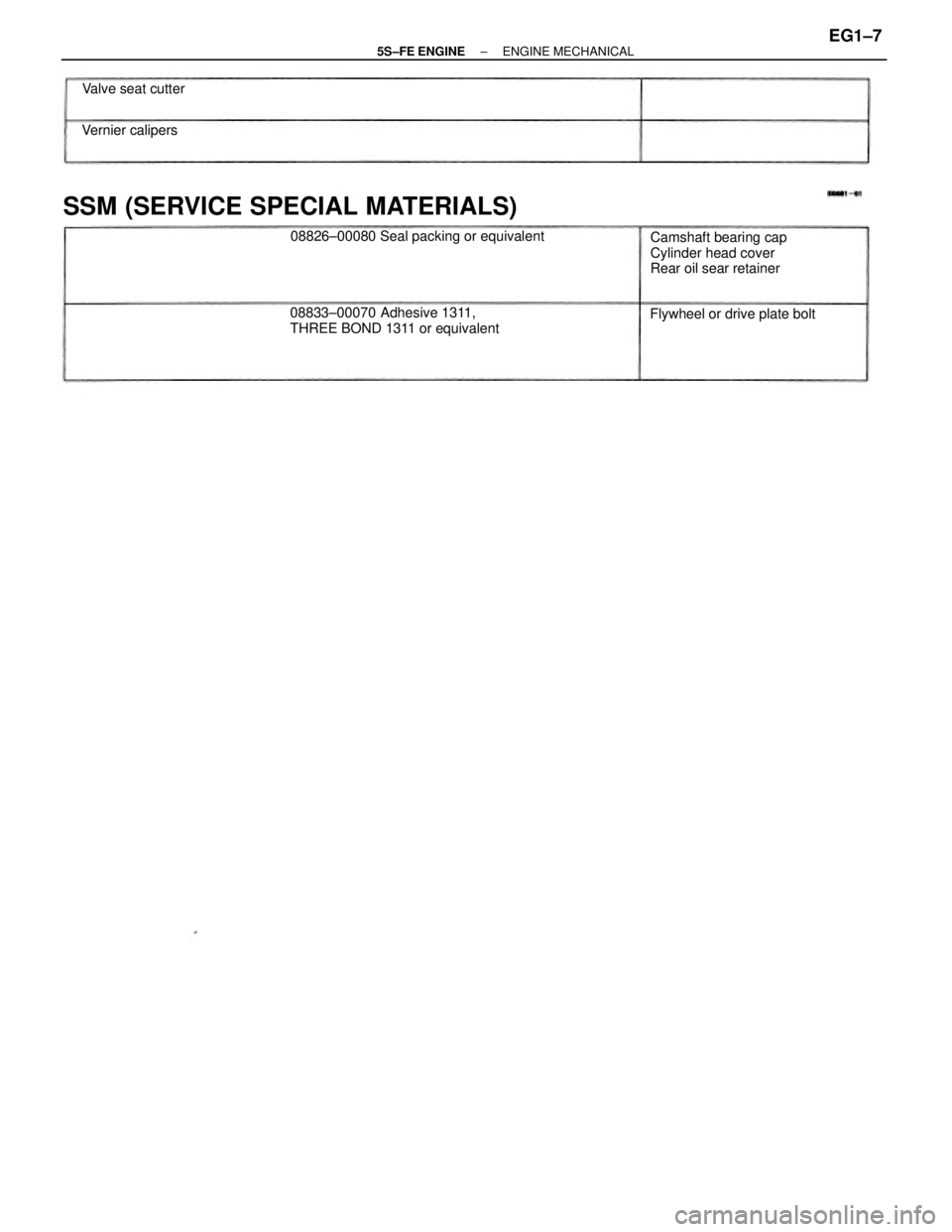
SSM (SERVICE SPECIAL MATERIALS)
08833±00070 Adhesive 1311,
THREE BOND 1311 or equivalentCamshaft bearing cap
Cylinder head cover
Rear oil sear retainer 08826±00080 Seal packing or equivalent
Flywheel or drive plate bolt Valve seat cutter
Vernier calipers
± 5S±FE ENGINEENGINE MECHANICALEG1±7
Page 64 of 4770

(b) Determine the replacement adjusting shim size by
following the Formula or Charts:
wUsing a micrometer, measure the thickness of
the removed shim.
wCalculate the thickness of a new shim so that the
valve clearance comes within specified value.
T ........... Thickness of removed shim
A ........... Measured valve clearance
N ........... Thickness of new shim
Intake:
N = T + (A ± 0.24 mm (0.009 in.))
Exhaust:
N = T + (A ± 0.33 mm (0.013 In.))
wSelect a new shim with a thickness as close as
possible to the calculated value.
HINT: Shims are available in seventeen sizes in incre±
ments of 0.05 mm (0.0020 in.), from 2.50 mm (0.0984
in.) to 3.30 mm (0.1299 in.).5. ADJUST VALVE CLEARANCE
(a) Remove the adjusting shim.
wTurn the crankshaft so that the cam lobe for the
valve to be adjusted faces up.
wUsing SST (A), press down the valve lifter and
place SST (B) between the camshaft and valve
lifter. Remove SST (A).
SST 09248 ± 55020 (09248 ± 05011, 09248±05021)
HINT: Before pressing down the valve lifter, position
its notch toward the spark plug side.
w Remove the adjusting shim with a' small screw±
driver and magnetic finger.
HINT: For easy removed of the shim, when positioning
SST (B), set it on the lifter so there is space enough to
be able to remove the shim.
± 5S±FE ENGINEENGINE MECHANICALEG1±14
Page 81 of 4770

TIMING BELT COMPONENTS INSPECTION
1. INSPECT TIMING BELT
NOTICE:
wDo not bend, twist or turn the timing belt Inside out.
wDo not allow the timing belt to come into contact
with oil, water or steam.
22. REMOVE CRANKSHAFT TIMING PULLEY
If the pulley cannot be removed by hand, use 2 screw±
drivers.
HINT: Position shop rags as shown to prevent
damage.20. REMOVE NO.1 IDLER PULLEY AND TENSION
SPRING
Remove the bolt, pulley and tension spring.
23. REMOVE OIL PUMP PULLEY
Using SST, remove the nut and pulley.
SST 09616±3001121. REMOVE NO.2 IDLER PULLEY
Remove the bolt and pulley.
± 5S±FE ENGINEENGINE MECHANICALEG1±31
Page 100 of 4770
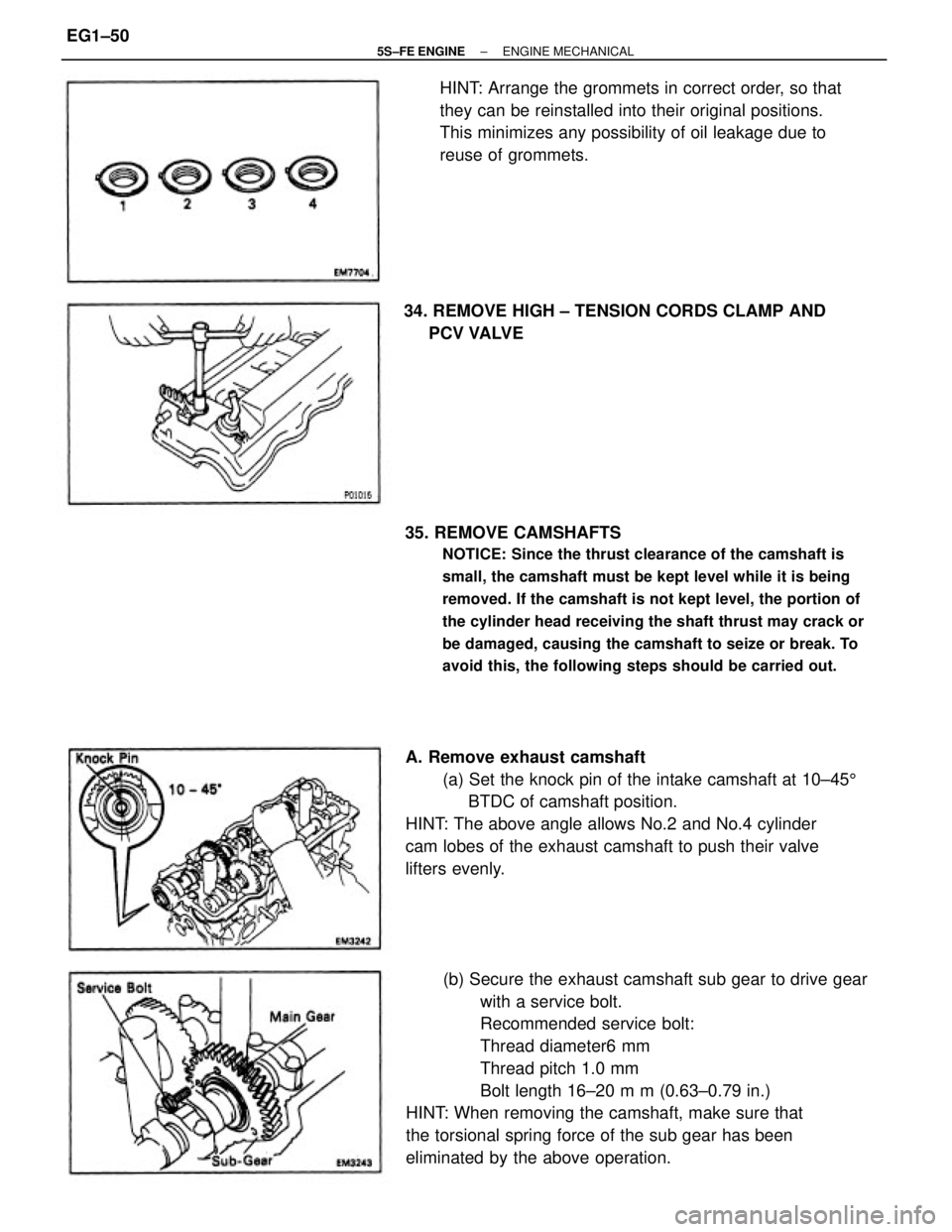
(b) Secure the exhaust camshaft sub gear to drive gear
with a service bolt.
Recommended service bolt:
Thread diameter6 mm
Thread pitch 1.0 mm
Bolt length 16±20 m m (0.63±0.79 in.)
HINT: When removing the camshaft, make sure that
the torsional spring force of the sub gear has been
eliminated by the above operation. 35. REMOVE CAMSHAFTS
NOTICE: Since the thrust clearance of the camshaft is
small, the camshaft must be kept level while it is being
removed. If the camshaft is not kept level, the portion of
the cylinder head receiving the shaft thrust may crack or
be damaged, causing the camshaft to seize or break. To
avoid this, the following steps should be carried out.
A. Remove exhaust camshaft
(a) Set the knock pin of the intake camshaft at 10±455
BTDC of camshaft position.
HINT: The above angle allows No.2 and No.4 cylinder
cam lobes of the exhaust camshaft to push their valve
lifters evenly.HINT: Arrange the grommets in correct order, so that
they can be reinstalled into their original positions.
This minimizes any possibility of oil leakage due to
reuse of grommets.
34. REMOVE HIGH ± TENSION CORDS CLAMP AND
PCV VALVE
± 5S±FE ENGINEENGINE MECHANICALEG1±50
Page 103 of 4770
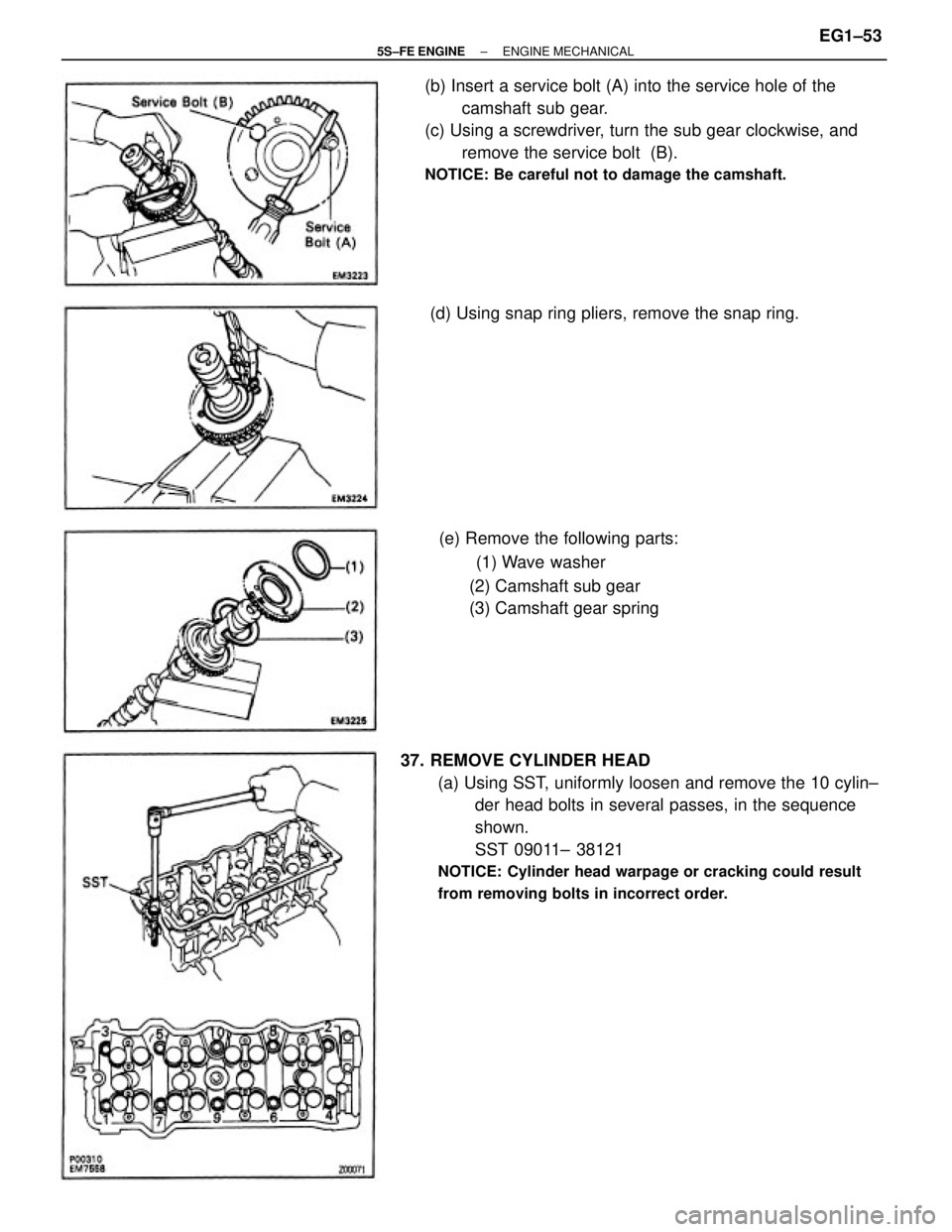
37. REMOVE CYLINDER HEAD
(a) Using SST, uniformly loosen and remove the 10 cylin±
der head bolts in several passes, in the sequence
shown.
SST 09011± 38121
NOTICE: Cylinder head warpage or cracking could result
from removing bolts in incorrect order.
(b) Insert a service bolt (A) into the service hole of the
camshaft sub gear.
(c) Using a screwdriver, turn the sub gear clockwise, and
remove the service bolt (B).
NOTICE: Be careful not to damage the camshaft.
(e) Remove the following parts:
(1) Wave washer
(2) Camshaft sub gear
(3) Camshaft gear spring (d) Using snap ring pliers, remove the snap ring.
± 5S±FE ENGINEENGINE MECHANICALEG1±53
Page 119 of 4770
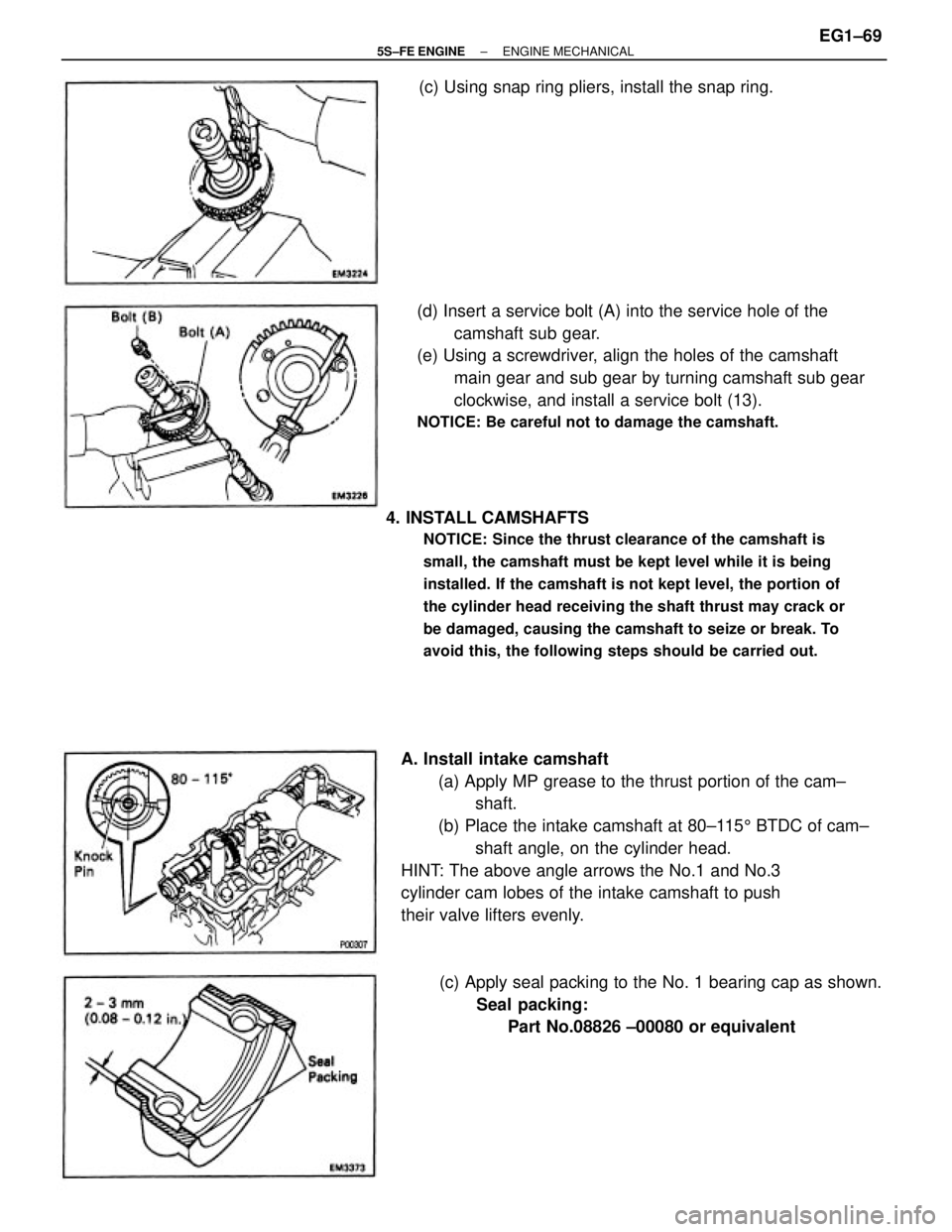
A. Install intake camshaft
(a) Apply MP grease to the thrust portion of the cam±
shaft.
(b) Place the intake camshaft at 80±1155 BTDC of cam±
shaft angle, on the cylinder head.
HINT: The above angle arrows the No.1 and No.3
cylinder cam lobes of the intake camshaft to push
their valve lifters evenly. 4. INSTALL CAMSHAFTS
NOTICE: Since the thrust clearance of the camshaft is
small, the camshaft must be kept level while it is being
installed. If the camshaft is not kept level, the portion of
the cylinder head receiving the shaft thrust may crack or
be damaged, causing the camshaft to seize or break. To
avoid this, the following steps should be carried out.
(d) Insert a service bolt (A) into the service hole of the
camshaft sub gear.
(e) Using a screwdriver, align the holes of the camshaft
main gear and sub gear by turning camshaft sub gear
clockwise, and install a service bolt (13).
NOTICE: Be careful not to damage the camshaft.
(c) Apply seal packing to the No. 1 bearing cap as shown.
Seal packing:
Part No.08826 ±00080 or equivalent (c) Using snap ring pliers, install the snap ring.
± 5S±FE ENGINEENGINE MECHANICALEG1±69
Page 139 of 4770

21. w/ A/C:
REMOVE A/C COMPRESSOR WITHOUT
DISCONNECTING HOSES
(a) Disconnect the A/C compressor connector.
(b) Remove the drive belt.
(c) Remove the 3 bolts, and disconnect the A/C compres±
sor.
HINT: Put aside the compressor, and suspend it to the
radiator support with a string.
24. REMOVE PS PUMP WITHOUT DISCONNECTING
HOSES
(a) Disconnect the 2 air hoses from the air pipe.
(b) Remove the PS drive belt.
(c) Remove the 2 bolts, and disconnect the PS pump from
the engine.
HINT: Put aside the pump and suspend it from the
cowl with a string. 22. DISCONNECT FRONT EXHAUST PIPE
(a) Loosen the 2 bolts, and disconnect the bracket.
(b) Using a 14 mm deep socket wrench, remove the 3
nuts holding the front exhaust pipe to the WU±TWC.
(c) Disconnect the front exhaust pipe and gaskets.
23. REMOVE DRIVE SHAFTS (See page SA±38)
25. DISCONNECT LH ENGINE MOUNTING INSULATOR
M/T:
Remove the 3 bolts, and disconnect the mounting
insulator.
A/T:
Remove the 4 bolts, and disconnect the mounting
insulator.
± 5S±FE ENGINEENGINE MECHANICALEG1±89
Page 151 of 4770
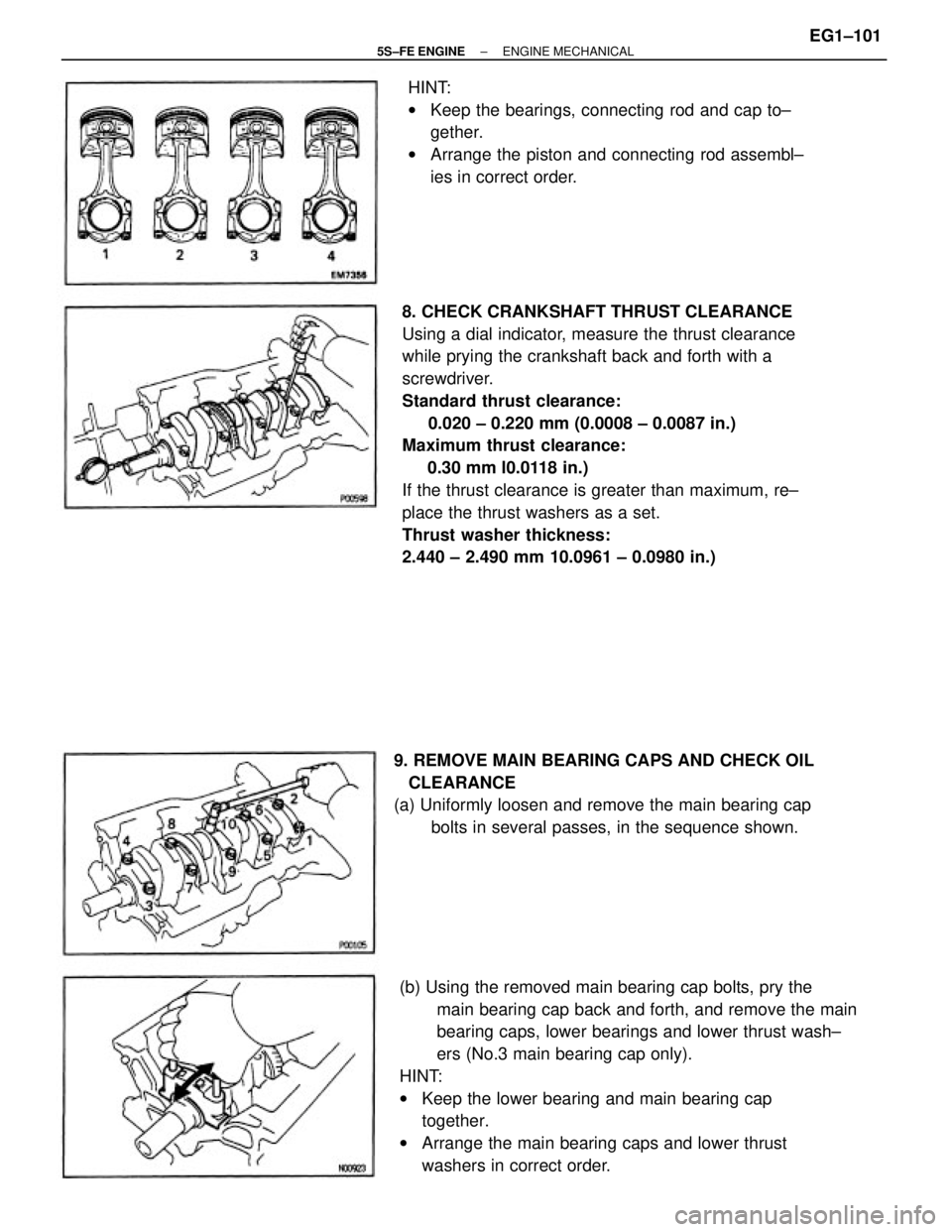
8. CHECK CRANKSHAFT THRUST CLEARANCE
Using a dial indicator, measure the thrust clearance
while prying the crankshaft back and forth with a
screwdriver.
Standard thrust clearance:
0.020 ± 0.220 mm (0.0008 ± 0.0087 in.)
Maximum thrust clearance:
0.30 mm l0.0118 in.)
If the thrust clearance is greater than maximum, re±
place the thrust washers as a set.
Thrust washer thickness:
2.440 ± 2.490 mm 10.0961 ± 0.0980 in.)
(b) Using the removed main bearing cap bolts, pry the
main bearing cap back and forth, and remove the main
bearing caps, lower bearings and lower thrust wash±
ers (No.3 main bearing cap only).
HINT:
wKeep the lower bearing and main bearing cap
together.
wArrange the main bearing caps and lower thrust
washers in correct order. HINT:
wKeep the bearings, connecting rod and cap to±
gether.
wArrange the piston and connecting rod assembl±
ies in correct order.
9. REMOVE MAIN BEARING CAPS AND CHECK OIL
CLEARANCE
(a) Uniformly loosen and remove the main bearing cap
bolts in several passes, in the sequence shown.
± 5S±FE ENGINEENGINE MECHANICALEG1±101